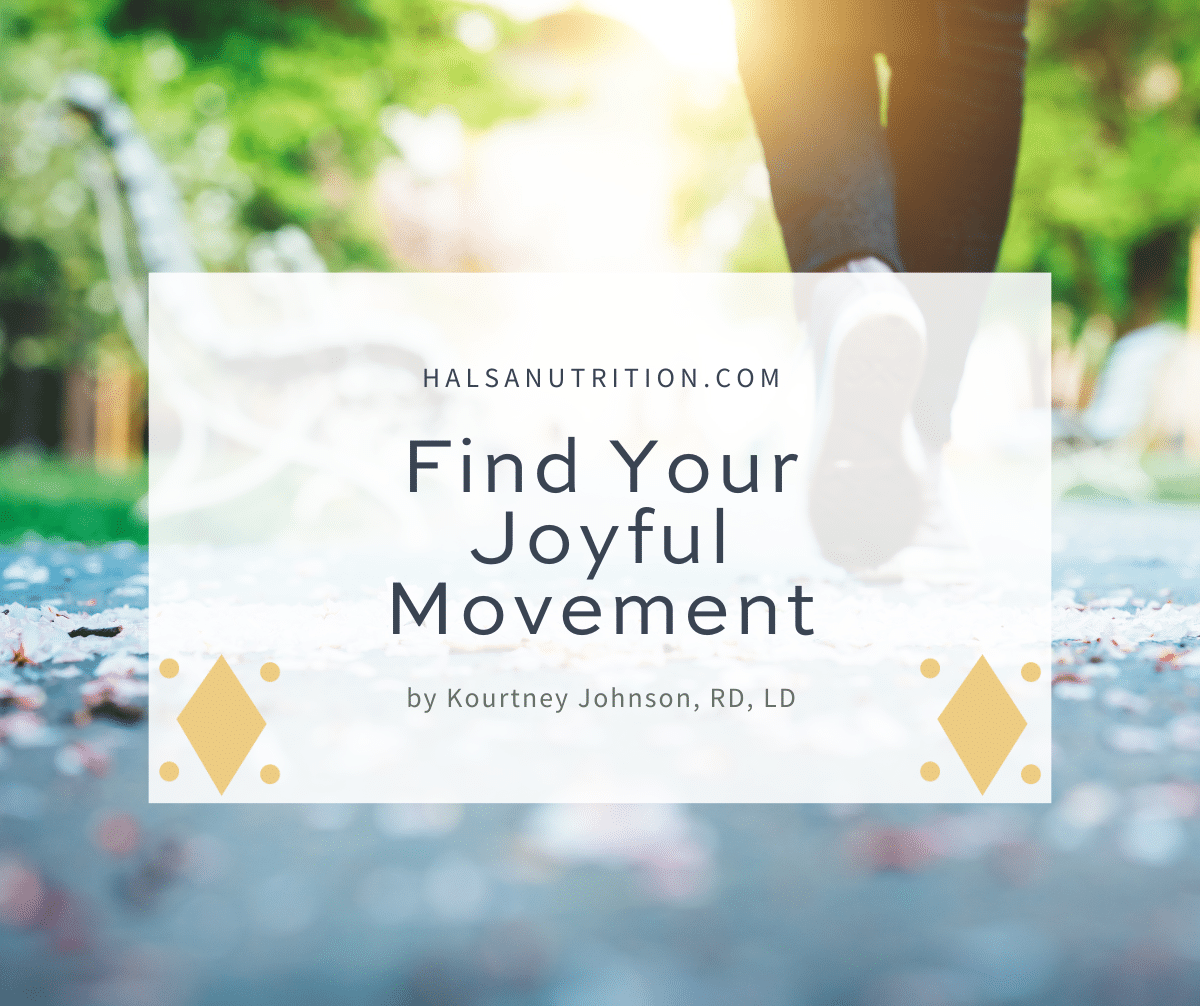
Find Your Joyful Movement
Estimated reading time: 5 minutes
by Kourtney Johnson, RD
Now that spring is here, you might be thinking about how it’s time to move your body more. The reasons could vary, from being cooped up inside during the winter to feeling pressure to shed pounds as you shed clothes.
As you’ve learned more about Intuitive Eating, maybe you’ve also become familiar with the term “joyful movement.” This is what the authors, Elyse Resch and Evelyn Tribole, call exercise, and it’s based on finding the activities that are right for you and your body.
This concept allows for more flexibility than the rigid exercise routines you might be used to. You don’t need to worry about doing certain workouts for specific amounts of time on a certain number of days per week, either!
Let’s dig in and figure out which movement is right for you and your body and explore all the benefits joyful movement offers.
How to discover your joyful movement
Think about what you liked to do for exercise as a child. Did you enjoy rollerblading? Swimming? Dancing? What would you do if you gave yourself permission to do whatever you wanted?

Diet culture tells us certain types of workouts are better and that if certain conditions aren’t met (like being covered in sweat or exercising for an hour), they don’t count. That’s why it can be difficult to find your joyful movement. It requires you to let go of that rigid mindset, which is another step away from diet culture.
However, I encourage you to simply try different activities to see what you like. You can always switch things up and incorporate different activities, from paddle boarding to walking to yoga, into your routine.
It might also help to include friends or family into your journey of trying out different types of movement. Maybe your best friend loves hiking and you’d like to bring her along, or your brother loves Karate. Having their support and excitement can make the experience that much better!
Avoid pressuring yourself to lose weight
Something else diet culture likes to tell us is that exercise is a way to lose weight. We tend to equate the two with each other, which usually ruins the fun moving your body can bring.
When changing your focus to joyful movement, try thinking about something else besides weight loss. Let’s say you’ve started going on walks with a friend. You could look at it as quality time with that person instead of time spent burning calories.
Maybe dancing brings out your inner child, and you feel on top of the world during and after! Isn’t that a much better motivator to move your body than simply wanting to shrink it?
Of course, changing your focus won’t happen overnight and will take time to get used to. That’s ok! When you notice thoughts about weight loss creeping in, remind yourself that there are other reasons to move your body.

Benefits of joyful movement
Moving your body has many advantages, no matter which activities you do. Besides making physical activity more enjoyable, the benefits of joyful movement include:
- Better mood
- Increased bone density
- Increased muscle mass
- Improved balance and flexibility
- Better sleep
Think about which benefits you get from your current exercise routine. Which other ones would you like to have by participating in joyful movement?

Be realistic about your goals
When you start your journey towards finding movement that you enjoy, make sure to be realistic. It might sound great to get your workout done in the morning before work, but if, in reality, you’d rather hit snooze and exercise later in the day, keep that in mind. Also, consider how much time you can spend participating in your joyful movement.
The takeaway here is to embrace the flexibility that joyful movement gives you!
Other Posts You Might Like
- The Connection Between Intuitive Eating and Diabetes
- HAES – A Better Approach to Health and Weight
- The Joy of Food: Why Eating for Health Isn’t Always the Most Important Thing
- 10 Non-Diet Books That Inspire
- The Honeymoon Phase in Intuitive Eating
About the Author
Kourtney is a registered dietitian who is passionate about sharing information related to intuitive eating and the harms of diet culture. She is from Minnesota but now lives in Spain, where she enjoys trying new foods and learning more about the culture there! In her free time, she likes to read, go to the beach, spend time with friends and family, and travel.
This article was edited and reviewed by Maria Adams, MS, MPH, RDN, LDN, a registered dietitian and Certified Intuitive Eating Counselor. Maria takes a weight-inclusive approach and helps individuals rediscover the joy of food and eat to feel their best by healing from chronic dieting and disordered eating. She holds a Bachelor of Science Degree in Nutrition Science, a Master of Science in Nutrition Communication, and a Master of Public Health.
Leave a Reply